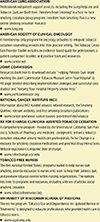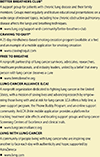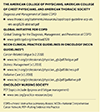Chronic Obstructive Pulmonary Disease: Clinical Implications for Patients With Lung Cancer
- PMID: 29547609
- PMCID: PMC6613547
- DOI: 10.1188/18.CJON.184-192
Chronic Obstructive Pulmonary Disease: Clinical Implications for Patients With Lung Cancer
Abstract
Background: Chronic obstructive pulmonary disease (COPD) is the most common smoking-related illness. COPD often is underemphasized as a comorbidity except when considering issues surrounding surgical treatment options.
Objectives: This article aims to provide nurses with an overview of the pharmacologic and nonpharmacologic treatment implications of COPD.
Methods: Definitions, differentials, and treatment considerations are provided, and clinical implications and resources are described.
Findings: The added burden of dyspnea, fatigue, and psychological distress related to COPD may affect the overall outcome and quality of life (QOL) of patients with lung cancer. Attention to the prevention, assessment, and treatment of lung cancer and COPD and related symptomatology will help maximize patients' QOL.
Keywords: chronic obstructive pulmonary disease; immunotherapy; lung cancer; quality of life.
Figures
Similar articles
-
Dyspnea management in lung cancer: applying the evidence from chronic obstructive pulmonary disease.Oncol Nurs Forum. 2005 Jul 1;32(4):785-97. doi: 10.1188/05.ONF.785-797. Oncol Nurs Forum. 2005. PMID: 15990908 Review.
-
Correlation of health-related quality of life with other disease severity indices in Indian chronic obstructive pulmonary disease patients.Int J Chron Obstruct Pulmon Dis. 2012;7:291-6. doi: 10.2147/COPD.S26405. Epub 2012 May 1. Int J Chron Obstruct Pulmon Dis. 2012. PMID: 22615528 Free PMC article.
-
The association of depression, anxiety, stress, and quality of life with the presence or absence of chronic obstructive pulmonary disease in lung cancer patients.Appl Nurs Res. 2025 Jun;83:151933. doi: 10.1016/j.apnr.2025.151933. Epub 2025 Mar 1. Appl Nurs Res. 2025. PMID: 40473369
-
Different impacts of respiratory symptoms and comorbidities on COPD-specific health-related quality of life by COPD severity.Int J Chron Obstruct Pulmon Dis. 2017 Nov 13;12:3301-3310. doi: 10.2147/COPD.S145910. eCollection 2017. Int J Chron Obstruct Pulmon Dis. 2017. PMID: 29180860 Free PMC article.
-
Non-pharmacological management of chronic breathlessness in stable chronic obstructive pulmonary disease.Br J Community Nurs. 2018 Aug 2;23(8):376-381. doi: 10.12968/bjcn.2018.23.8.376. Br J Community Nurs. 2018. PMID: 30063393 Review.
Cited by
-
A Prospective Pilot Study Evaluating Feasibility and Preliminary Effects of Breathe Easier: A Mindfulness-based Intervention for Survivors of Lung Cancer and Their Family Members (Dyads).Integr Cancer Ther. 2020 Jan-Dec;19:1534735420969829. doi: 10.1177/1534735420969829. Integr Cancer Ther. 2020. PMID: 33118443 Free PMC article.
-
Mindfulness-Based Symptom and Stress Management Apps for Adults With Chronic Lung Disease: Systematic Search in App Stores.JMIR Mhealth Uhealth. 2018 May 15;6(5):e124. doi: 10.2196/mhealth.9831. JMIR Mhealth Uhealth. 2018. PMID: 29764800 Free PMC article. Review.
-
COPD and Immune Checkpoint Inhibitors for Cancer: A Literature Review.Int J Chron Obstruct Pulmon Dis. 2024 Dec 9;19:2689-2703. doi: 10.2147/COPD.S490252. eCollection 2024. Int J Chron Obstruct Pulmon Dis. 2024. PMID: 39677829 Free PMC article. Review.
References
-
- American Lung Association. (2018). Better Breathers Club. Retrieved from http://www.lung.org/support-and-community/better-breathers-club
-
- Bianchi R, Gigliotti F, Romagnoli I, Lanini B, Castellani C, Grazzini M, & Scano G (2004). Chest wall kinematics and breathlessness during pursed-lip breathing in patients with COPD. Chest, 125, 459–465. - PubMed
MeSH terms
Grants and funding
LinkOut - more resources
Full Text Sources
Other Literature Sources
Medical




